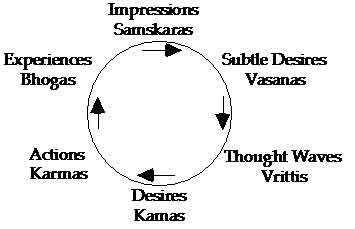Editor's Note: Dr. Miller has translated several classical Indian texts from Sanskrit into English. This is the fourth part of Richard's translation of Patanjali's Yoga Sutras, along with his rich insights and incisive commentary.
Read Previous Chapters
I. 17-22
Absorption: Samprajñāta and Asamprajñāta Samādhi
Patañjali now presents six sutras that differentiate ever subtler states of meditation that enable us to go beyond what normally binds attention (prakṛti),
in order to attain a glimpse of Essential Nature (puruṣa) and the flowering of freedom from suffering.
What is the process of meditative absorption?
I. 17. vitarka - vicāra - ānanda - asmitārūpa -
anugamāt - saṁprajñātaḥ
vitarka: logical reasoning; gross thought
vicāra:
subtle discriminative inquiry
ānanda: ecstasy; bliss
asmitā rūpa: I-ness
anagamat:
accompanied by four movements
samprajñāta: cognitive samādhi with division between seer and seen
samādhi: absorption (sam: together; adhi: to direct, uniting with)
The realization of unconditioned Essential Nature is initially accompanied by gross logical thinking, subtle discriminative inquiry, feelings of joy or bliss, and identification with being a separate observer or ego-I-self.
When the mind is directed towards a chosen object, understanding of the object gradually deepens, whether the object chosen is of the ever-changing nature
of the body, mind, senses and world (prakṛti) or towards unchanging Essential Nature (puruṣa). The
ultimate aim of Patañjali’s teachings on absorptive meditation (dhārana, dhyāna,
and samprajñāta and asamprajñāta samādhi) is the release from the limitations imposed by the mind’s
identification and fusion with the ever-changing aspects of the body, mind, and senses, so that attention is freed from these identifications and can,
instead, turn into and realize our true identity as unchanging Essential Nature.
Like peeling an onion, each successive stage of inquiry leaves the ones that come before it behind, as an ever-deepening level of absorption is attained.
That said, however subtle and sustained, it is important to understand that all stages of concentration maintain an element of distance between
one’s self as subject (observer), and the object that is being inquired into (observed). This distance keeps in place identification with one’s self as a
separate ego-I seer (observer), in reference to the object seen (observed). The ultimate aim of absorptive meditation is to realize that this distance is
simply a product of thought, and does not actually exist, except as a misperception by the mind. Now, let us examine the first five stages of meditation
that Patañjali describes as belonging to absorptive meditation (samprajñāta samādhi).
1. Vitarka: The object of meditation is perceived at a gross cognitive level.
a. Savitarka Samādhi: Gross logical reasoning is used to perceive the object of meditation. This involves the use of words (śabdha), imagery (artha), and
ideas (jñāna). Words, images and ideas are never the object itself, but merely mental representations of
the object perceived. For instance, a rose is neither the alphabetical letters, ‘r’, ‘o’, ‘s’, ‘e’, or the spoken word “rose”. The word/image/idea “rose”
is only a representation that resides in the mind.
b. Nirvitarka Samādhi: Here gross thinking falls away, but conceptual thought is still being engaged to move us ever closer towards being absorbed in the
actual object.
2. Vicāra: The object of meditation is perceived at a subtle cognitive level (tanmātra).
a. Savicāra Samādhi: Awareness of time, space, and self as a separate observer is present.
b. Nirvicāra Samādhi: Awareness of time, space, and self as a separate observer begin to dissolve.
3. Ānānda: As subtle thought begins to dissolve feelings of deep peace, equanimity, and great joy or
bliss arise as conceptual thinking becomes ever-subtler.
a. Sānānda Samādhi: Joy arises with the increasing disengagement from the sense organs, and a subtler
independence from conceptual thinking.
b. Nirānāda: Joy dissolves, as absorption becomes free of conceptual cognitive reasoning.
4. Asmitā: All that remains is a subtle pre-cognitive feeling of being a separate observer or “I-am-ness” that is aware of the chosen object of meditation.
a. Sasmitā: A gross pre-cognitive feeling of I-amness is present, which supports the feeling of being a separation observer to what is being observed. As
Essential Nature becomes the object of contemplation, there continues a separation from Essential Nature. One continues to misperceive the ego-I to be the
true observer.
b. Nirasmitā: I-ness all but disappears and becomes so transparent that Essential Nature begins to be recognized as the true observer or “I-amness” of
itself. One begins to realize that the observer and the observed are one and the same, Essential Nature.
During there remains a division between the observer and the observed, however subtle. The sense of separation created by the ego-I observer is becoming
more and more transparent, but during samprajñāta samādhi there always remains an object of concentration, and a division between the seer and the seen.
During Asamprajñāta Samādhi the misperception of being a separate ego-I observer of Essential Nature dissolves. Misperception and identification with the
changing aspects of nature (prakṛti) dissolve and Essential Nature (puruṣa) is realized to be the true Seer, the true Self.
Levels of Samādhi
|
Samādhi
|
Inquiry
|
Kosha
|
Chakra
|
Element
|
Covering
|
Meditation
|
|
1. Savitarka
|
Sensation
|
Annamaya
|
Mūlādhāra
|
Earth (prithivī)
|
Niyati
|
Dhārana
|
|
2. Nirvitarka
|
Energy
|
Prānāmaya
|
Svādhisthāna
|
Water (ap)
|
Kāla
|
Dhyāna
|
|
3. Savicāra
|
Emotion
|
Manomaya
|
Manipura
|
Fire (tejas)
|
Rāga
|
Samādhi
|
|
4. Nirvicāra
|
Cognition
|
Vijñānamaya
|
Ātma
|
Air (vāyu)
|
Vidya
|
Nirodha
|
|
5. Sānāada
|
Bliss
|
Ānāndamaya
|
Anāhata
|
Space (ākāsha)
|
Kalā
|
Samādhi
|
|
6. Nirānanda
|
Pervading
|
Asmitāmaya
|
Vishuddhā
|
Subtle (sūksma)
|
Shuddha
|
Ekakrata
|
|
7. Sasmitā
|
Interpenetrating
|
Asmitāmaya
|
Ajñā
|
Subtle (sūksma)
|
Īshvara
|
Ekakrata
|
|
8. Sasmitā
|
Empty
|
Asmitāmaya
|
Sāhasrāra
|
Subtle (sūksma)
|
Sadā Śiva
|
Ekakrata
|
|
9. Sasmita
|
Formless
|
Asmitāmaya
|
Narayanana
|
Subtle (sūksma)
|
Śakti
|
Ekakrata
|
|
10. Nirasmitā
|
Pure I-ness
|
Asmitāmaya
|
Bramānanda
|
Subtle (sūksma)
|
Śiva
|
Ātma Bhava
|
|
11. Kaivalya
|
Absolute
|
Beyond
|
Beyond
|
Beyond
|
Parā Samvit
|
Dharma Mega
|

Scandinavia Trip, Photo by Peter Boel
Where does the process of absorption lead?
I. 18. virāmapratyaya - ābhyāsapūrvaḥ - saṁskāraśeṣāḥ - anyaḥ
virāma: absence or cessation of disturbances in the mind
pratyaya: content of the mind at any given moment
ābhyāsa: right practice
pūrvaḥ: is preceded by
saṁskāra: impressions
śeṣāḥ: remnants
anyaḥ: asamprajñāta samādhi
Different from samprajñāta samādhi is thepractice of asamprajñāta samādhi. Here, cessation of all effort, even at meditating, spontaneously arises, which leads to a deep settling of the mind into peace, equanimity and the
underlying stillness of simply being. Only remnant impressions of thoughts, memories and images remain, which constitute the sense of
identification as a separate “I”, “me” or seer, even as knowing begins to arise that the true Seer is not the ego-I (ahamkara) but Essential Nature
(puruṣa).
Asamprajñāta samādhi is brought about through constant practice and complete release and disidentification (para- vairāgya) from the changing circumstances of the mind, and the realization of Essential Nature as
the true Seer, beyond the limitations of the conceptual mind. When identification with the mind ceases, only latent impressions remain and no new
impressions arise.
The Wheel of Identification
The function of the mind is to move, wherein each movement of the mind gives rise to subsequent movements. Among the movements created by the mind is the
impression of being an observer, seer, “I” or “me” who is either aware of, or identified with the various movements of body, mind, senses, emotions and
thoughts.
Impressions by the senses that register within the mind give rise to subtle desires, which cause new thoughts to arise, which give rise to gross desires,
which give rise to actions that are initiated into the world, which create experiences, which give rise to new impressions, desires, thoughts, actions,
experiences, new impressions, and so on in an endless cycle of birth and death.

Cycle of birth and death
Meditation allows this cycle to be understood as simply a function of the
body, mind and senses. This insight frees attention from this cycle of birth, growth, stability, decay and death. Attention is now free to inquire into the
nature of the seer, which ultimately is realized to be Essential Nature, which has always been free from this cycle. This realization leads to the complete
disidentification and freedom “from” this cycle, the realization of our Essential Nature as the true “seer”, and the subsequent ending of suffering.
What should one understand with respect to impressions that remain in the mind?
I. 19. bhavapratyayo - videhaprakṛtilayānāṁ
bhava: birth; objective existence; caused by
pratyaya: content of consciousness
videha: beyond body consciousness; disidentification with the body but not yet obtained the fullness of self-realization
prakṛtilayānāṁ: having attained sasmitā samādhi but having not gone further
As long as residual impressions remain, there remains the possibility for re-identification and fusion with these remnant impressions (prakṛti)
and the subsequent re-identification with being a separate ego-I, or “me”.
Even upon the attainment of asamprajñāta samādhi and realization of Essential Nature as the true seer, there still remains the possibility of rebirth and
re-identification with the latent impressions that continue to be present in consciousness. which can give rise again to fusion with the changing states of
mind and re-identification with being a separate ego-I self.
There are four states of consciousness (avastha) that the mind can become identified with and confused by:
1. Jagra: The waking state in which the senses and mind are turned outward into identifications with the gross changing states of
body, mind, senses and world, and away from Essential Nature.
2. Svapna: The sleeping state or condition of consciousness during sleep, after death, or in reverie; where there is identification with subtle objects of
body, mind, and senses.
3. Sushupti: The deep-sleep state of blankness, but wherein there is self-awareness and a subtle sense of being a separate observer ego-I of this blank
state.
4. Turiya: The “fourth” state wherein Essential Nature is awake to Itself as the true seer.
During the initial stages of meditation (samādhi) the seer, as ego-I, is aware of and identified with the ever-changing movements of the mind, body,
senses, and world. Here, the seer remains identified as a separate experiencer of sensations, emotions, and cognitions, as a separate thinker, experiencer,
and performer of actions.
In the later stages of meditation (samādhi) the ego-I seer is realized to be just another conceptual
thought, albeit subtle. Identification with the changing states of body, mind, and senses ceases. There is absorption in and as Essential Nature.

Scandinavia Trip, Photo by Peter Boel
Aspects of Mind
Manas: The conscious mind, which performs the function of receiving, storing, and forwarding sense-impressions to the intellect (buddhi) for discriminative
evaluation. A portion of these impressions are acted upon, resolved and completely dissolve, while remaining impressions pass into the subconscious mind,
where they are stored for later evaluation by the intellect.
Buddhi: The aspect of mind that reasons, rationalizes, arranges, and evaluates sensory perceptions. It is the intellect that blossoms into intuition.
Intellect is an integrating function, and is comprised of a balance between reason (mental) and heart (feeling).
Ahamkara: The ego-I principle that gives rise to the sense of being a personal I-me-mine who possesses and acts, and is born and dies.
Citta: The storehouse of impressions that are gathered and acted upon by the three other aspects of mind. Citta functions as a reference library. It is
responsible for memorization, retention, and mental recollection.
These four aspects of the mind function in intimate reciprocation. For example, when a shining pebble of gold is attained, the eye-sense convey its golden
brilliance to the mind (manas) and these impressions are stored in consciousness (citta). The intellect (buddhi) then evaluates and recognizes that gold is
valuable and that material desires can be satisfied through its possession. The ego-I (ahamkara) then comes in and says: “This gold is mine.” The
ego-I function then worries about how to use or keep the gold safe from others. These impressions of worry are then added to the subconscious storehouse of
impressions (citta).
What is the role of faith, will-power, and memory in the process of realizing Essential Nature?
I. 20. śraddhā - vīrya - smṛti - samādhiprajñā - pūrvaka - itareṣām
śraddhā: faith; trust
vīrya: enthusiasm; energy; indomitable will
smṛti: remembrance
samādhi: absorption; focused concentration
prajñā: higher knowledge necessary for samādhi
pūrvakah: preceded by
itareṣām: in others
In the case of most
, realization of Essential Nature is preceded by, and proceeds from faith, enthusiastic devotion to practice, will-power,
constant remembering of the teachings, and right understanding of meditative absorption.
For most people, faith is the underlying force that moves one ever-onwards towards realization of Essential Nature. Faith provides the energy and
willingness to persist, in spite of repeated failures. Faith enables us to constantly remember the teachings and to devotedly engage in persistent
practice. Meditation strengthens faith and faith, in turn, strengthens meditation.
The realization of Essential Nature is not the result of chance, or the achievement of psychic powers, or the result of insights bestowed upon us by
teachers. Realization is the culmination of persistent, patient and persevering self-discipline, which enables right understanding to fully blossom
within ourselves.
Four qualifications help nourish right understanding that leads to realization of Essential Nature:
1. Faith (śraddhā): The firm conviction that the truth we seek lies within ourselves, and that the
teachings and practice of yoga will enable us to realize Essential Nature. Faith is not based on belief, which can be shaken, but upon deep inner
certainty.
Faith entails the qualities of deep curiosity, respect, love, equanimity, and absolute devotion to truth. Faith brings forth and strengthens these
attitudes, and these attitudes bring forth and strengthen faith.
Faith gives rise to an inner felt-sense that all is well (well-being); that we are standing on firm ground no matter our circumstance; that we are treading
the right path. Faith protects. Faith inspires conviction, self-confidence and reliance on our own inner resources. Faith gives rise to trust that does not
require proof or evidence. Faith is not mere hope or petition, but is based upon deep motivation and absolute trust that what we seek will be revealed.
2. Determination (vīrya): The inner resolute determination, courage, and willfulness to patiently, persistently, and perseveringly overcome all obstacles.
Yoga is not a path for the faint of heart. It is the path of determination to persist in spite of doubts and obstacles that inevitably arise along the way.
3. Memory (smṛti): Memory entails our capacity to learn from our experiences and retain these memories in consciousness so that we can drawn upon our
experience as we move ever onward towards the realization of Essential Nature.
4. Wisdom (prajñā): Wisdom is acquired through sustained attention that is consistently turned towards truth and the realization of Essential Nature. It
entails our ability to discern and engage discriminative (para-vairāgya) wisdom and insight (prajña).

Photo by Michael Christopher Brown
The Use of Memory for the Realization of Essential Nature
-
At first, we utilize the function of memory to embed conceptual names that describe and point us in the direction of Essential Nature. Embedding such
concepts into memory enables the repetition of these concepts that repeatedly bring before the mind images of Essential Nature so that the remembrance
of Essential nature is fixed firmly in the mind.
-
Second, we remember that Essential Nature is already residing within us. We continue remembering the symbol—concept/word—that represents Essential
Nature, repeating the word in order to keep our mind focused on our desire to realize Essential Nature.
-
Third, we patiently, persistently, perseveringly, and devotionally remember our desire to realize Essential Nature. Our thoughts repeatedly return to
remembering our yearning for freedom from suffering. Every sensation, emotion and thought we experience is paired with our desire to realize Essential
Nature.
-
Fourth, memory is utilized in the midst of all actions, and during in all states of consciousness. During all of our worldly pursuits, we keep in mind
our desire to realize Essential Nature. When this is so, it may be said that we are firmly established in a yogic state of meditation 365-24-7.
-
Fifth, we constantly observe what is arising in the mind and abandon every state that otherwise distracts the mind from remaining focused upon and
absorbed in the desire to realize Essential Nature. Absorption (asamprajñāta samādhi) is established when self-forgetfulness
disappears and memory is firmly oriented in every moment to realizing and awakening as Essential Nature.
-
Sixth, sensations, emotions, thoughts, and images that arise in the mind that are other than Essential Nature are noticed and set aside. In this way we
reach a state of equanimity wherein the mind and sense organs grow completely still. Outer and inner objects lose their ability to distract. Through
discrimination and constant recollection of Essential Nature, the mind is purified and is freed from all thoughts other than those that are oriented
towards the realization of Essential Nature.
Is the goal of yoga near or far?
I. 21. tīvrasamvegānām - āsānnaḥ
tīvra: intense
samveganam: momentum
āsānnaḥ: close at hand
Realization of Essential Nature is always close at hand when there is intense enthusiasm, energy, sincerity, and devotion to speedily overcome all obstacles that stand in the way of realizing Essential Nature.
In the words of the 13th century ecstatic poet Kabir, “It is the intensity of the longing that does all the work.” The more ardently you desire to
reach the goal, the swifter your progress. It is far easier to realize Essential Nature than it is to reach down and pick a flower. In the case of the
flower there is distance involved, while in the case of Essential Nature there is no physical distance to traverse for it is already what you are. To
achieve success in the material world, you have to deal with the minds of many. To achieve success in yoga you only need deal with your own mind. To bring
success in the material world requires that you add things to yourself. Yoga requires that you let go of things. Realization of Essential Nature is only
brought about by letting go of the belief that you are not Essential Nature.
Essential Nature is already the case.
It is not something to be added, achieved,
or in any way obtained.
Realizing this clearly
meditation is easy to understand.
If you are walking and suddenly stop,
there is no more walking.
If you are minding and suddenly stop,
there is no more minding.
In the wondrous delight of just being,
truth is always revealing Itself, to Itself
Mind and truth will never meet.
but Essential Nature is always here
whether mind is,
or is not. —richard miller
What allows some to attain the goal of yoga, while others do not?
I. 22. mṛdu - madhya - ādhimātratvāt - tato 'pi - viśeṣaḥ
mṛdu: mild
madhya: moderate
ādhimātratvāt: intense
tataḥ: in these
api: also
viśeṣaḥ: superior results
There is a distinction between those who possess mild, moderate, or intense enthusiasm, desire, energy, and willfulness for
realizing Essential Nature. The realization of Essential Nature is always close at hand for those who are intensely one-pointed in their desire
for realization.
Not everyone possesses the same intensity or longing for truth. Variation in capacity varies from mild and moderate to intense. Faith (śraddhā) underlies
one’s intensity for realizing truth. The most intense form of energy comes when all other pursuits are given up and the mind becomes occupied only with the
task at hand: the realization of Essential Nature. Only then is constant practice possible.
In the sutras that follow, Patañjali proposes a variety of means for reducing or removing the sources of distraction that otherwise prevent realization of
Essential Nature.